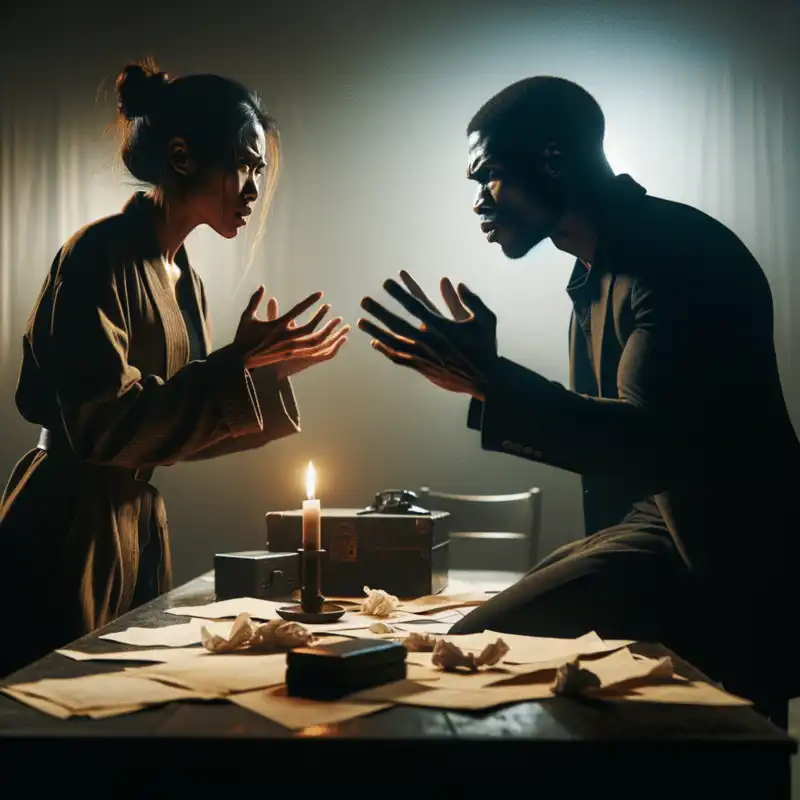Conflict: Key to Plot Growth

Posted on: 2025-05-19
By: Livia Galloway
Conflict is not just an obstacle; it is the driving force that shapes compelling narratives. As you embark on your writing journey, consider how effectively you incorporate conflict to captivate your readers and deepen character development. Are you ready to elevate your storytelling?
What You Will Learn
- Conflict is the essential element that keeps readers engaged in a story, serving as the heartbeat of the narrative.
- Understanding different types of conflict, such as character versus character, self, society, and nature, enhances both character development and plot progression.
- Conflict drives character decisions and establishes stakes, compelling readers to invest in the characters' journeys and the outcomes.
- Mixing internal and external conflicts can enrich the narrative, providing depth and complexity to character struggles.
- Raising the stakes within the story increases urgency and tension, making it difficult for readers to put the book down.
- Meaningful conflict resolution should lead to character growth and a satisfying conclusion, ultimately transforming the story.
- Reflecting on personal writing practices regarding conflict can help identify areas for improvement and enhance reader engagement.
- Exploring themes through conflict can create a deeper connection with readers, making stories more impactful.
Types of Conflict in Storytelling
The essential types of conflict that drive narratives forward are highlighted below, showcasing how they shape character development and plot progression.
Character vs. Character
This dynamic conflict arises from friction between two characters, often leading to intense confrontations that drive the plot.
Character vs. Self
Internal struggles reveal profound fears and desires, showcasing the character's journey towards self-realization.
Character vs. Society
This conflict highlights struggles against societal norms or injustices, often leading to significant character development.
Character vs. Nature
Struggles against natural forces illustrate survival scenarios, testing the limits of the characters.
The Critical Role of Conflict in Plot Development
Every compelling story thrives on conflict. It's the very heart that keeps readers glued to the page, eager to see how situations unfold. Without conflict, narratives can feel flat and uninteresting, making it crucial for writers to grasp its significance. Think of conflict as the spice in your favorite dish—without it, everything might be bland!
At Fiction Flourish, I believe that understanding this essence is key for aspiring writers. Conflict serves not just as an obstacle but as a catalyst that propels characters into action, forcing them to confront their fears, desires, and the world around them. When readers witness characters facing challenges, it creates a connection with them, sparking emotions that turn passive reading into an engaging experience.
Understanding the Essence of Conflict in Narrative
Let’s dive deeper into why conflict is the backbone of storytelling. Primarily, it sets the stage for tension and excitement. Readers naturally crave resolution and will stick around to see how conflicts resolve. Without these challenges, the journey can lack direction, making it essential to weave conflict throughout your narrative. For more on exploring types of storytelling techniques, see our related article.
Moreover, think of conflict as a way to unveil your characters. When faced with trials, their true personalities shine through! This not only helps in character development but also enhances the plot, drawing readers into the emotional core of the story. So, how can we categorize conflict in our stories? Let’s look at some key types:
- Character vs. Character: This is often the most dynamic type, where two characters create friction.
- Character vs. Self: Internal struggles that reveal deep fears and desires.
- Character vs. Society: Challenges against societal norms or injustices.
- Character vs. Nature: Struggles against natural forces, like survival scenarios.
The Function of Conflict in Fictional Narratives
Conflict operates in various ways within stories, acting as a driving force behind the plot. First, it shapes the narrative direction, as characters make choices based on their conflicts. These choices lead to consequences that push the story forward, creating ripples that affect the entire narrative landscape.
Additionally, effective conflict reveals the stakes involved. Whether the stakes are emotional, physical, or societal, they compel readers to invest in the characters' journeys. By establishing high stakes, you enhance the story’s urgency, making it hard for readers to put the book down! To illustrate this, consider these functions of conflict:
- Establishes stakes: Higher stakes mean greater reader investment.
- Drives character decisions: Conflicts force characters to make choices that define their arcs.
- Creates suspense: Unresolved conflicts build anticipation and tension.
Before delving into the diverse types of conflict, you might find it useful to explore tips for plot development for beginners to better understand how conflict fits into the bigger picture.
Diverse Types of Conflict That Propel Stories Forward
Conflicts come in many forms, each serving a particular purpose in storytelling. Understanding these variations helps writers like you create richer, more compelling narratives. But what are these types, and how do they affect your story?
By exploring internal and external conflicts, you can enhance your understanding of character struggles and the challenges they face in the world around them. This exploration will not only help you craft more engaging stories but also resonate with your readers on a deeper level. Let’s break down these concepts further!
Pro Tip
As you craft your narratives, remember to consider the emotional stakes involved in your conflicts. Characters who face personal dilemmas or moral choices resonate more with readers. For instance, a character torn between loyalty and justice can create a profound emotional connection, making the conflict not just about winning or losing, but about growth and transformation.
FAQs About Conflict in Storytelling
Frequently Asked Questions
- What is the main purpose of conflict in a story?
- Conflict keeps readers engaged and drives the plot forward, creating tension and prompting character development.
- What are the main types of conflict in storytelling?
- The main types are Character vs. Character, Character vs. Self, Character vs. Society, and Character vs. Nature.
- Why is it important to mix internal and external conflicts?
- Mixing these types of conflicts adds depth and complexity to the characters and their struggles, enriching the narrative.
- How do high stakes enhance a story?
- High stakes increase the urgency and tension, making readers more invested in the outcome of the story.
- What should be the outcome of conflict resolution?
- Conflict resolution should lead to character growth and a satisfying conclusion, transforming the story in a meaningful way.
Summarizing the Impact of Conflict on Storytelling
As we wrap up our exploration of conflict, it's clear that it plays a vital role in shaping our stories! Conflict is more than just a plot device; it serves as the heartbeat of a narrative, keeping readers engaged and invested in the characters’ journeys. Whether it’s a fierce battle against an external enemy or the internal struggle of a character wrestling with their own demons, conflict drives the story forward and adds depth to our narratives.
Reflecting on the insights we've discussed, it’s important to recognize that conflict not only enhances plot development but also enriches character arcs. Characters evolve through their challenges, and these developments resonate with readers, creating a more meaningful connection. In essence, conflict is what transforms a simple tale into a powerful story.
Actionable Takeaways and Next Steps for Writers
Now that we’ve delved into the significance of conflict, let’s discuss some *actionable takeaways* to integrate this knowledge into your writing practice. Here are a few strategies to consider as you weave conflict into your narratives:
- Identify Core Conflicts: Determine the main conflict in your story and ensure it aligns with your character’s goals.
- Mix Internal and External Conflicts: Combine different types of conflict to create a richer narrative tapestry.
- Raise the Stakes: Introduce obstacles that challenge your characters and heighten tension.
- Resolve Conflicts Meaningfully: Ensure that the resolution of conflicts leads to character growth and a satisfying conclusion.
At Fiction Flourish, we believe that understanding these techniques can significantly enhance your storytelling skills! So take a moment to reflect on your current project and think about how you can incorporate more conflict to enliven your plot.
Encouraging Reflection on Personal Writing Practices
Let’s take a few moments to reflect on your own writing practices. Have you thought about how conflict could elevate your stories? Here are some guiding questions to help you evaluate your work:
- What are the primary conflicts in my story? Are they clear and compelling?
- Do my characters face challenges that contribute to their growth?
- Am I balancing internal and external conflicts effectively?
- How can I increase the stakes for my characters?
By considering these questions, you can identify areas where conflict can enrich your narratives, leading to stronger engagement with your audience. For more on crafting complex characters and how they interact with conflict, explore our character crafting resources.
Resources for Further Exploration and Learning
To take your understanding of conflict to the next level, here are some resources that I highly recommend:
- Books: Titles like "The Anatomy of Story" by John Truby or "Save the Cat!" by Blake Snyder offer fantastic insights into crafting conflict.
- Workshops: Participate in local or online writing workshops focused on plot development and conflict.
- Writing Prompts: Use prompts that focus specifically on conflict scenarios to spark creativity.
- Online Courses: Websites like MasterClass and Skillshare offer courses on storytelling that include sections on conflict.
These tools can assist you in refining your skills and expanding your knowledge of conflict in storytelling. Remember, continuous learning is a key part of your growth as a writer!
Exploring Themes in Conflict
Finally, let’s consider how conflict can illuminate the central themes of your story. When we understand the underlying themes, we can craft conflicts that resonate on a deeper level. For instance:
- Self-Discovery: Internal conflicts often lead characters on journeys of self-discovery, allowing themes of identity to emerge.
- Justice vs. Injustice: External conflicts can reflect societal issues, exploring themes of justice or moral dilemmas.
- Love and Sacrifice: Conflicts in relationships can highlight themes of love, sacrifice, and loyalty.
By weaving these themes into your conflicts, you create a richer and more engaging experience for your readers. As you continue your writing journey with Fiction Flourish, I encourage you to embrace conflict as a powerful tool for storytelling. Happy writing!
Recap of Key Points
Here is a quick recap of the important points discussed in the article:
- Conflict is Essential: Every compelling story thrives on conflict, serving as the heart that keeps readers engaged.
- Types of Conflict: Understand the different types, such as Character vs. Character, Character vs. Self, Character vs. Society, and Character vs. Nature.
- Conflict Drives Progress: It shapes narrative direction, reveals stakes, and compels character decisions.
- Mix Conflicts: Combine internal and external conflicts to create richer narratives.
- Raise the Stakes: Heighten tension by introducing challenges that push characters to their limits.
- Meaningful Resolutions: Ensure that conflicts resolve in ways that contribute to character growth and a satisfying conclusion.
 Did you know that effective storytelling can not only captivate your audience but also improve your
Did you know that effective storytelling can not only captivate your audience but also improve your
 Did you know that the emotional resonance of a story often hinges on the relationship between plot a
Did you know that the emotional resonance of a story often hinges on the relationship between plot a
 Character relationships serve as the backbone of storytelling, shaping plots and engaging readers on
Character relationships serve as the backbone of storytelling, shaping plots and engaging readers on